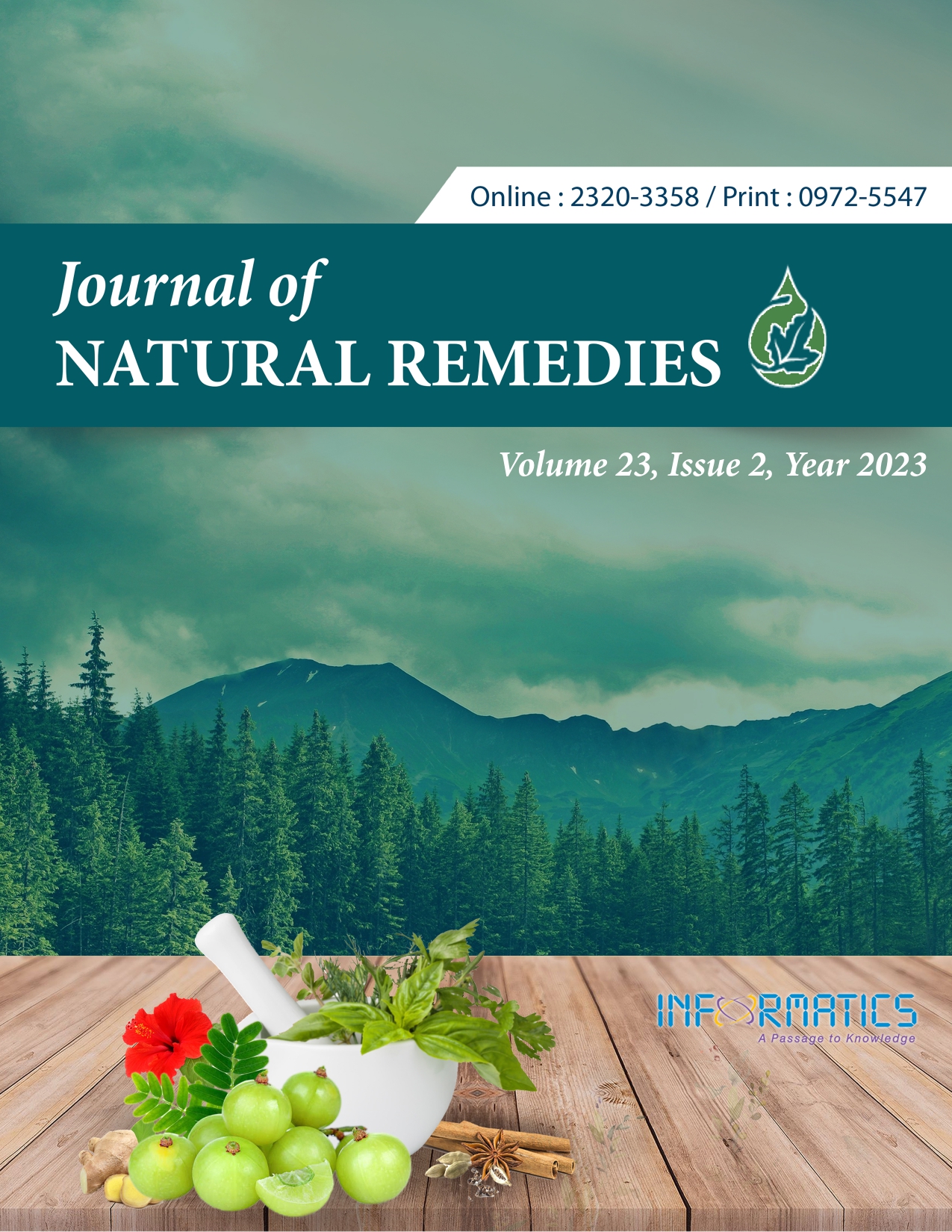Alleviating Potential of Zingiber officinale and Cow Urine Distillate Co-administered with Levetiracetam in Epileptic Rats: A Pharmacokinetic and Pharmacodynamics Approach
study of Levetiracetam in pilocarpine-induced epilepsy
DOI:
https://doi.org/10.18311/jnr/2023/33217Keywords:
Catalase and Nitrate, Cow Urine Distillate, Epilepsy, Levetiracetam, Zingiber officinale ExtractAbstract
Background: Epilepsy is a severe neurological condition that affects all ages of people. Complex pathways involved in pathogenesis make it complicated to treat; selected antiepileptic drug options are available for Epilepsy. There is a need for an hour to develop novel treatment approaches for epilepsy with lesser side effects. This research aimed to evaluate the alleviating role of bio-enhancers co-administered with levetiracetam for pilocarpine-induced epilepsy. Methodology: Pilocarpine (250 mg/kg) was used to develop epilepsy in rats. Levetiracetam (LEV) (140 mg/kg) was administered with Zingiber officinale Extract (ZOE) (15 mg/kg and 30 mg/kg) and Cow Urine Distillate (CUD) (1.5 ml/kg and 3 ml/kg). HPLC was used to evaluate drug concentration in blood. Serum nitrate, catalase, CRP, calcium level and calcium level of the brain, behavioural markers in rats were assessed and compared with the Leviteracetam group only. Result and Discussion: The present study showed that combining ZOE and CUD with levetiracetam was advantageous through substantial reduction (p < 0.05) in serum nitrate, CRP and increased catalase (p < 0.05), while reduced serum calcium compared to LEV alone. Combination of ZOE and CUD with levetiracetam treatment also reduced seizure behaviour and duration in rats. The bioavailability of LEV in plasma and brain was increased when epileptic rats were treated with LEV plus ZOE and CUD compared to disease control. Conclusion: Utilization of Zingiber officinale and CUD in combination with LEV was proven therapeutically effective in the epileptic model and used to lower the dose of LEV along with reducing seizure behaviour and time with the potential for the treatment of epilepsy.
Downloads
Metrics
Downloads
Published
How to Cite
Issue
Section
License
Copyright (c) 2023 Nilay Solanki, Harshal Patel, Milap Patel , Yamini Patel, Preetu Shukla, Jagdish Kakadiya, Rajesh Maheshwari, Priyal Chauhan (Author)

This work is licensed under a Creative Commons Attribution 4.0 International License.
Accepted 2023-04-24
Published 2023-06-13
References
Available from: https://www.who.int/news-room/fact-sheets/detail/epilepsy
Alexander A, Qureshi A, Kumari L, Vaishnav P, Sharma M, Saraf S, et al. Role of herbal bioactives as a potential bio-availability enhancer for Active Pharmaceutical Ingredients. Fitoterapia. 2014; 97:1-14. https://doi.org/10.1016/j. fitote.2014.05.005 PMid:24862064 DOI: https://doi.org/10.1016/j.fitote.2014.05.005
Mohanty I, Senapati MR, Jena D, Palai S. Diversified uses of cow urine. Int J Pharm Pharm Sci. 2014; 6(3):20-2.
Qazi G, Bedi K, Johri R, Tikoo M, Tikoo A, Sharma S, et al. Bioavailability enchancing activity of Zingiber officinale Linn and its extracts/fractions thereof. Google Patents; 2003.
Trinka E, Cock H, Hesdorffer D, Rossetti AO, Scheffer IE, Shinnar S, et al. A definition and classification of status epilepticus- Report of the ILAE task force on classification of status epilepticus. Epilepsia. 2015; 56:1515-23. https://doi.org/10.1111/epi.13121 PMid:26336950 DOI: https://doi.org/10.1111/epi.13121
Available from: https://tribuneonlineng.com/epilepsy-how-ginger-boosts-effectiveness-of-medicine/
Meghana A, Obulapathi U, Singh S. Indian cow urine as a therapeutic alternative in treatment of human diseases: A review. AYUHOM. 2021; 8(2):57.
Zheng Y, Moussally J, Cash SS, Karnam HB, Cole AJ. Intravenous levetiracetam in the rat pilocarpine-induced status epilepticus model: Behavioral, physiological and histological studies. Neuropharmacology. 2010; 58(4-5):793-8. https://doi.org/10.1016/j.neuropharm.2009.12.007 PMid:20026136 PMCid:PMC2834228 DOI: https://doi.org/10.1016/j.neuropharm.2009.12.007
Al-Shorbagy MY, El Sayeh BM, Abdallah DM. Additional antiepileptic mechanisms of levetiracetam in lithium-pilocarpine treated rats. PloS one. 2013; 8(10):e76735. https://doi.org/10.1371/journal.pone.0076735 PMid:24098559 PMCid:PMC3789684 DOI: https://doi.org/10.1371/journal.pone.0076735
Li Y, Schellhorn HE. Rapid kinetic microassay for catalase activity. Journal of Biomolecular Techniques: JBT. 2007; 18(4):185.
Patsalos P. Pharmacokinetic profile of levetiracetam: Toward ideal characteristics. Pharmacology and Therapeutics. 2000; 85(2):77-85. https://doi.org/10.1016/S0163-7258(99)00052-2 PMid:10722121 DOI: https://doi.org/10.1016/S0163-7258(99)00052-2
Pucci V, Bugamelli F, Mandrioli R, Ferranti A, Kenndler E, Raggi MA. High‐performance liquid chromatographic determination of Levetiracetam in human plasma: Comparison of different sample clean‐up procedures. Biomedical Chromatography. 2004; 18(1):37-44. https://doi.org/10.1002/bmc.289 PMid:14872547 DOI: https://doi.org/10.1002/bmc.289
Racine RJ. Modification of seizure activity by electrical stimulation: II. Motor seizure. Electroencephalography and Clinical Neurophysiology. 1972; 32(3):281-94. https://doi.org/10.1016/0013-4694(72)90177-0 PMid:4110 397 DOI: https://doi.org/10.1016/0013-4694(72)90177-0
Waldbaum S, Patel M. Mitochondrial dysfunction and oxidative stress: A contributing link to acquired epilepsy? Journal of Bioenergetics and Biomembranes. 2010; 42(6):449-55. https://doi.org/10.1007/s10863-010-9320-9 PMid:21132357 PMCid:PMC3102435 DOI: https://doi.org/10.1007/s10863-010-9320-9
Mohseni G, Ostadhadi S, Akbarian R, Chamanara M, Norouzi-Javidan A, Dehpour A-R. Anticonvulsant effect of dextrometrophan on pentylenetetrazole-induced seizures in mice: Involvement of nitric oxide and N-methyl-d-aspartate receptors. Epilepsy and Behavior. 2016; 65:49-55. https://doi.org/10.1016/j.yebeh.2016.08.001 PMid:27875784 DOI: https://doi.org/10.1016/j.yebeh.2016.08.001
Ogunro P, Mustapha A, Salau A. Lipid peroxidation and antioxidant status in patients with primary generalized epilepsy. Arch Appl Sci. 2013; 5:68-74.
Rahman S. Pathophysiology of mitochondrial disease causing epilepsy and status epilepticus. Epilepsy and Behavior. 2015; 49:71-5. https://doi.org/10.1016/j.yebeh.2015.05.003 PMid:26162691 DOI: https://doi.org/10.1016/j.yebeh.2015.05.003
Mattson MP. Excitotoxicity. Neurodegeneration. 2017:37-45. https://doi.org/10.1002/9781118661895.ch4 DOI: https://doi.org/10.1002/9781118661895.ch4
Aguiar CCT, Almeida AB, Araújo PVP, Abreu RNDCd, Chaves EMC, Vale OCd, et al. Oxidative stress and epilepsy: Literature review. Oxidative Medicine and Cellular Longevity. 2012; 2012. https://doi.org/10.1155/2012/795259 PMid:22848783 PMCid:PMC3403512 DOI: https://doi.org/10.1155/2012/795259
Santos LF, Freitas RL, Xavier SM, Saldanha GB, Freitas RM. Neuroprotective actions of vitamin C related to decreased lipid peroxidation and increased catalase activity in adult rats after pilocarpine-induced seizures. Pharmacology Biochemistry and Behavior. 2008; 89(1):1-5. https://doi.org/10.1016/j.pbb.2007.10.007 PMid:18096215 DOI: https://doi.org/10.1016/j.pbb.2007.10.007
Liguori C, Romigi A, Izzi F, Placidi F, Nuccetelli M, Cordella A, et al. Complement system dysregulation in patients affected by idiopathic generalized epilepsy and the effect of antiepileptic treatment. Epilepsy Research. 2017; 137:107-11. https://doi.org/10.1016/j.eplepsyres.2017.09.005 PMid: 28985614 DOI: https://doi.org/10.1016/j.eplepsyres.2017.09.005
Woernle CM, Neidert MC, Wulf M-A, Burkhardt J-K, Grunwald T, Bernays R-L. Excessively elevated C-reactive protein after surgery for temporal lobe epilepsy. Clinical neurology and Neurosurgery. 2013; 115(8):1245-9. https://doi.org/10.1016/j.clineuro.2012.11.025 PMid:23266263 DOI: https://doi.org/10.1016/j.clineuro.2012.11.025

 Nilay Solanki
Nilay Solanki









 0.35
0.35 24
24 0.161
0.161